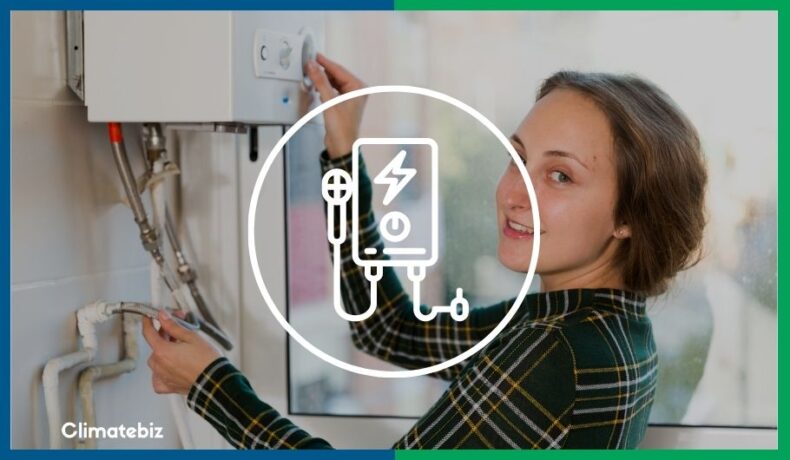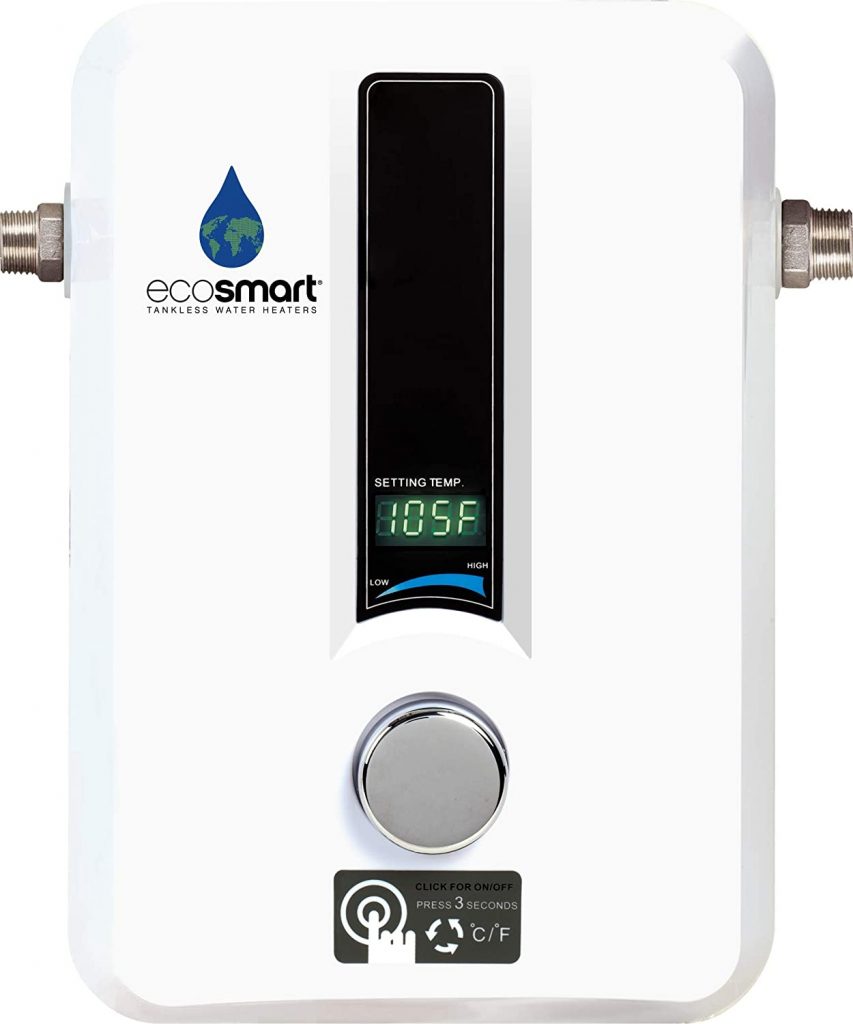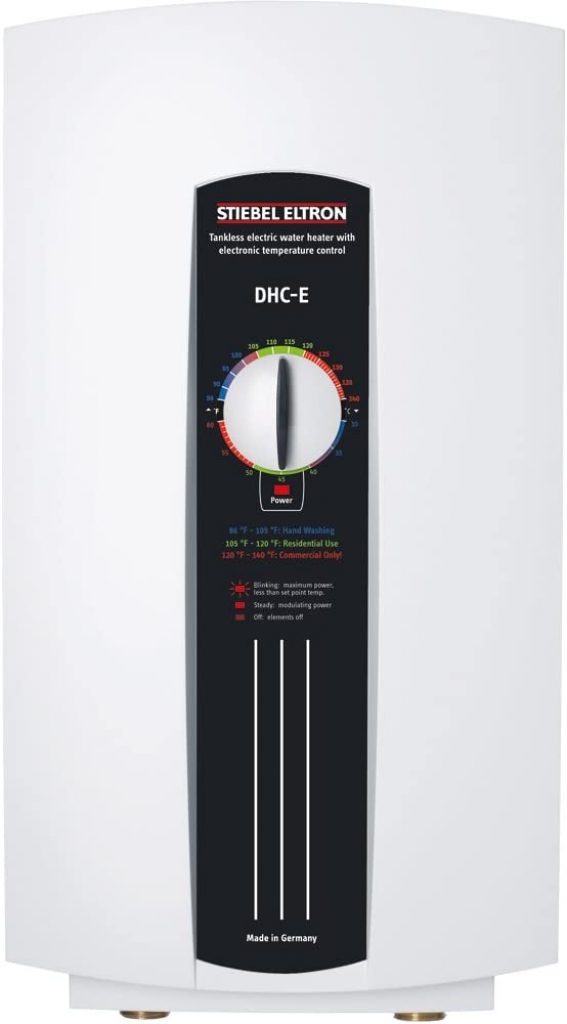Fed up with excessive electrical bills? Tired of waiting for your geyser to heat up after one too many showers? Then it’s time that you invest in a tankless water heater!
Demand-type water heaters are incredibly successful at overcoming the notorious standby heat loss issue and lengthy waiting times associated with conventional storage water heaters.
What does that mean for you? It means access to hot water continuously, efficiently, and in a more cost-effective manner.
Sound appealing? Then you’ll love what’s in store!
Table of Contents
What Is A Tankless Water Heater?
A tankless water heater (TWH) provides a continuous supply of hot water on demand. Unlike conventional storage heaters, you’ll have access to hot water in a shorter time without heat loss from the storage tank.
In these systems, cold water travels through a pipe into the unit. Then, either an electric element or a gas burner heats the water (when required). As long as you have access to power, you’ll never run out of hot water.
There are two types of tankless water heaters: whole-house & point-of-use.
Whole-House
Whole-house water heater units, also known as centralized water heaters, are large and have high gallons per minute (GPM) flow rate. This increased capacity means that they can handle water pressure demand from more than one faucet at a time.
For instance, a whole-house water heater can supply hot water to a running shower, dishwasher, and washing machine all at the same time. Naturally, this makes them a more expensive option than their point-of-use counterparts.
Technically speaking, you can install multiple point-of-use tankless water heaters to achieve the same end goal, but that process could be rather tedious.

Point-Of-Use
A point-of-use tankless water heater is smaller than a whole-house system. As such, they have a lower flow rate, so they can only cater to the needs of one faucet/outlet.
On the upside, they are cheaper, and their size means that you can place them inside cramped spaces, like a closet or cabinet.
This water heater can come in handy for additional faucets that your current system may not cover. For instance, a POU water heating system would be perfect for a property with a separate building/room.
The Appeal
These water heaters are appealing for several reasons:
- Energy-Efficient: they can reduce energy consumption by 20%-30%.
- Cost-Effective: these systems don’t need to continuously heat storage tanks full water — saving you money!
- Space-Saving: their generally smaller sizes make them far less invasive.
How Does A Tankless Water Heater Work?
Tankless water heaters use either gas or electricity to heat up your water.
Gas-fired tankless water heaters are either condensing or non-condensing:
Non-Condensing
Most gas-fired TWHs are non-condensing. These units are the more basic form of gas-fired tankless water heaters; most people convert from a traditional tank water heater to these units.
These units vent steam, which cools down outside of the unit. This steam needs to be vented through corrosion and heat-resistant channels. As such, they only require one heat exchanger.
The resulting exhaust gases are at far higher temperatures (upwards of 302 degrees Fahrenheit and are vented directly instead of being looped through the heater.
Condensing
A condensing TWH can recycle extra heat. It’s a closed system that vents excess vapor when it’s no longer required for the heating process.
You’ll find that vapor from these systems is much cooler. As such, a condensing TWH does not require expensive and complex venting materials: a standard PVC pipe will be able to cope with the heat and corrosiveness of the steam.
Second Heat Exchanger
Condensing units have an additional heat exchanger designed to loop exhaust through the system before releasing it.
The exhaust gas is cooled inside the system, and the resulting condensation water is collected. This condensation is then neutralized inside the unit and expelled.
Electric Tankless Water Heater
- As soon as hot water is required, cold water flows into the heater, where three separate electrical resistive elements heat it.
- The water temperature increases as it passes through each heating segment so that the final desired temperature is reached at the third and final element.
- The microprocessor control board regulates the amount of energy needed to heat the water to the temperature set by the user. Inlet cold water temperature, outlet hot water temperature, and water flow are monitored, and the power is adjusted accordingly.
- Due to the absence of a storage tank, the heater requires less space, meaning that it may be placed near the hot water demand location. This, in turn, reduces heat losses.
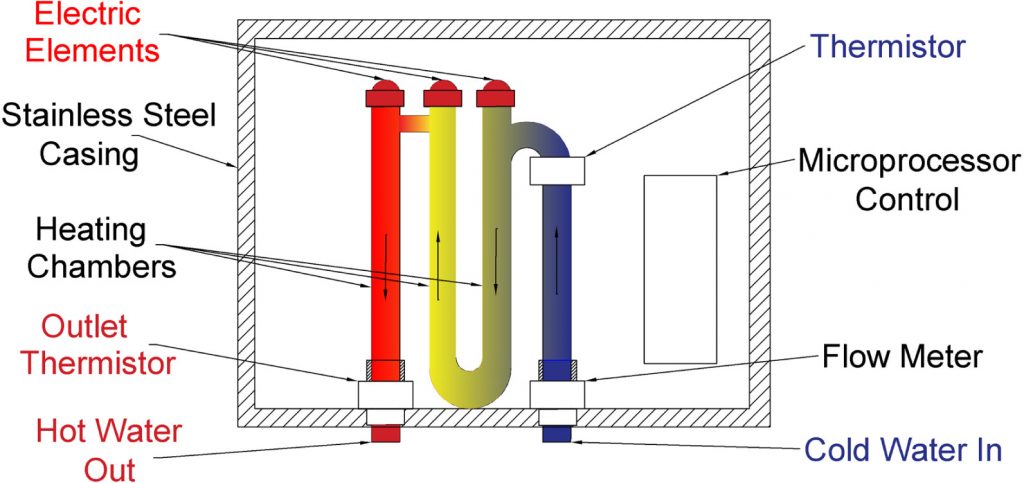
Source: Energy Reports
Gas-Fired Tankless Water Heater
- This tankless water heater is powered by igniting liquefied petroleum gas. This produces a constant flame that is maintained by a regulator control valve.
- The flame produces thermal energy that is then captured by heating fins. These heating fins exchange the energy to the water flowing through conductive pipes.
- Sensors located at the cold water (inlet) and hot water (outlet) valves send data to a microprocessor, which decides to increase or decrease the gas flowing to the burner.
- The gas supply will increase within operating limits if the temperature at the hot water outlet side is below the desired temperature set by the user. Similarly, the gas will decrease if the water temperature exceeds the desired temperature.
- The water flow rate can be adjusted to suit the user’s needs, but an increase in flow rate will require an increase in gas supply to the burner.
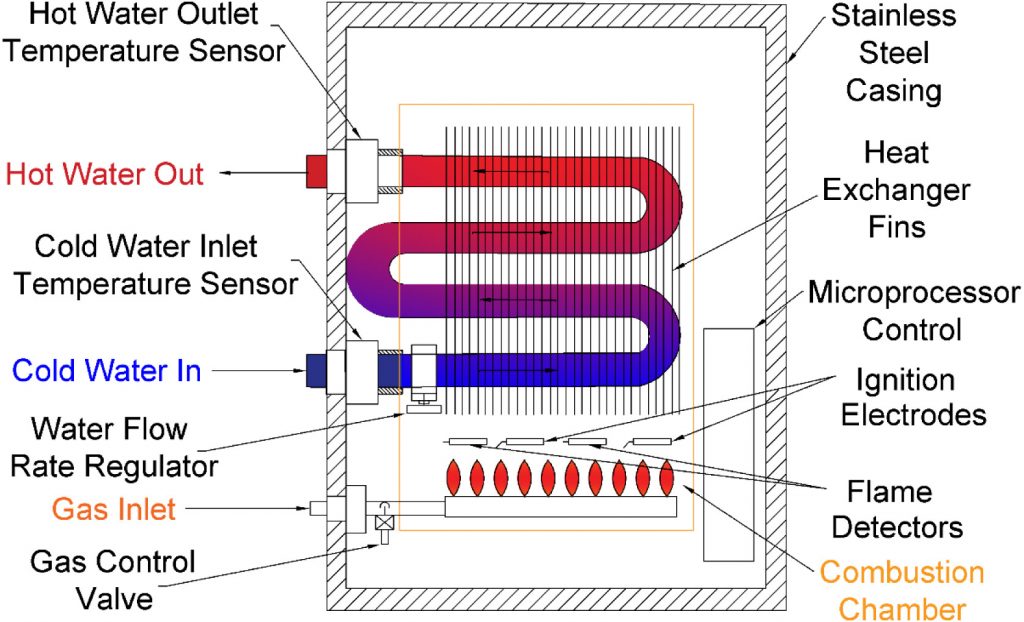
Source: Energy Reports
Flow Rate
Generally, a POU unit produces between 0.5 – 2 gallons of hot water per minute, while a whole-house system produces between 5 – 10 gallons per minute.
As you can see, the difference between the two is rather significant — what you choose will ultimately depend on your needs (and your budget).
However, if you need hot water for more than one faucet but your budget is tight, don’t despair! You can install POU tankless water heaters in parallel sequence to meet water demand through multiple faucets.
Gas Vs. Electric
Gas-fired demand heaters tend to have higher flow rates than their electric counterparts.
However, electric water heaters are cheaper to run. Why? Because electric TWHs are much more efficient (98 to 99%) than gas-fired TWHs (80% to 85%).
This increased efficiency level offsets gas is generally cheaper than electricity (sorry, gas lovers).
How Long Does A Tankless Water Heater Last?
The majority of tankless water heaters tend to have a lifespan of more than 20 years — no complaints there!
What’s more, they have easily replaceable parts that can extend their lifespan for many more years.
How Are Tankless Water Heaters Installed?
Let’s run through a typical installation process for an electric and gas-fired tankless water heater.
Gas-Fired Heater Installation
Step 1: The old geyser is shut off, drained, and removed.
Step 2: A new demand heater may require a larger gas line. This line must run from the gas meter to the water heater.
Step 3: A hole saw is used to drill a hole in the home’s exterior near the water heater’s location. Then, PVC pipes are installed for air intake and ventilation.
Step 4: Next, the cold water supply line is connected to the water heater, and the hot lines out of the heater using a ¾” copper pipe.
Step 5: An electrical outlet is required — a qualified electrician should assist with this step.
Step 6: A crossover valve can be added at the furthest plumbing fixture to allow the recirculation pump to keep hot water at the ready.
Step 7: Finally, the cold water supply and gas supply are turned on to test.
(Courtesy of This Old House)
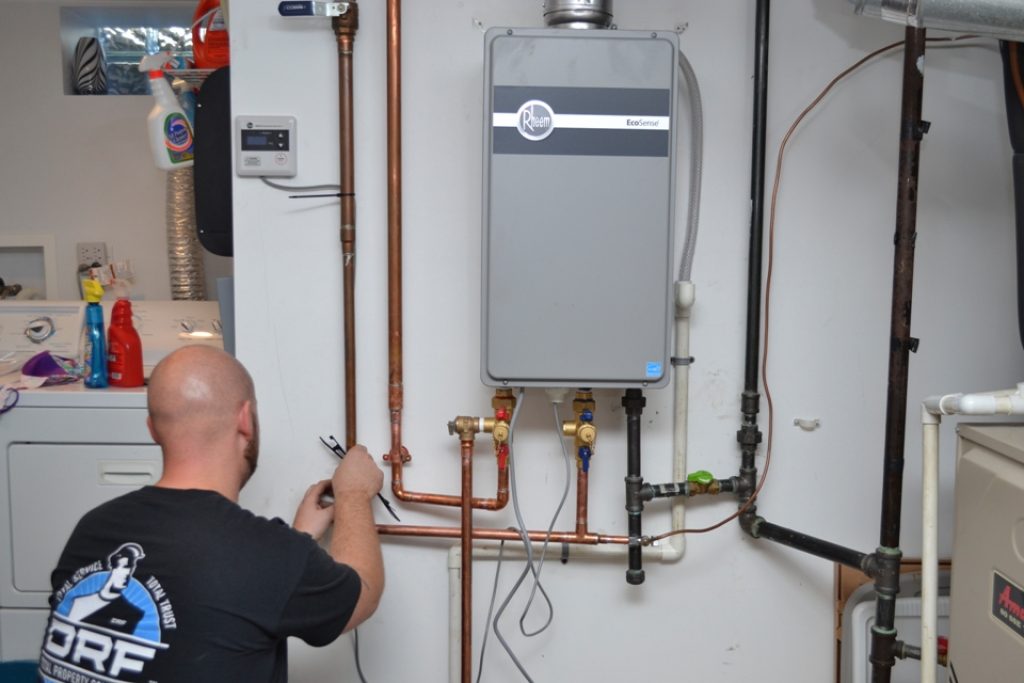
Source: Sweet Home Advisor
Electric Heater Installation
Step 1. First, an appropriate place for the water heater installation is identified. It’s mounted vertically, directly to the wall, with the power and water supply connections at the bottom of the unit.
Step 2. The hanging bracket is removed from the back of the water heater; it’s then held against the wall in the desired mounting location. The wall is marked, the supplied wall anchors are inserted, and the bracket is screwed into these anchors.
Step 3. The front cover is removed, and the plug connecting the LCD panel to the unit is disengaged. The front cover is then removed and hung on the wall bracket.
Step 4. The power supply is then connected to the appropriate section of the terminal block.
Step 5. The LCD cable is then re-attached, and the unit’s front cover is replaced.
Step 6. The water connections are connected to the water supply using a metal hose. Valves are also added to the unit supply so that the water supply can be turned off without shutting off water to the rest o the house.
Step 7. After the water connections are made, the hot water tap is turned on, and the air is purged from the pipes. Once the water flows consistently, a check is conducted for leaks.
Step 8. Finally, power can be connected to the circuit breaker, the breakers are turned on, and hot water is readily available.
(Courtesy of Marey Heater)
How Does A Tankless Water Heater Save On Costs?
To answer this question correctly, let’s compare a storage heater to a tankless water heater.
Conventional Storage Heater
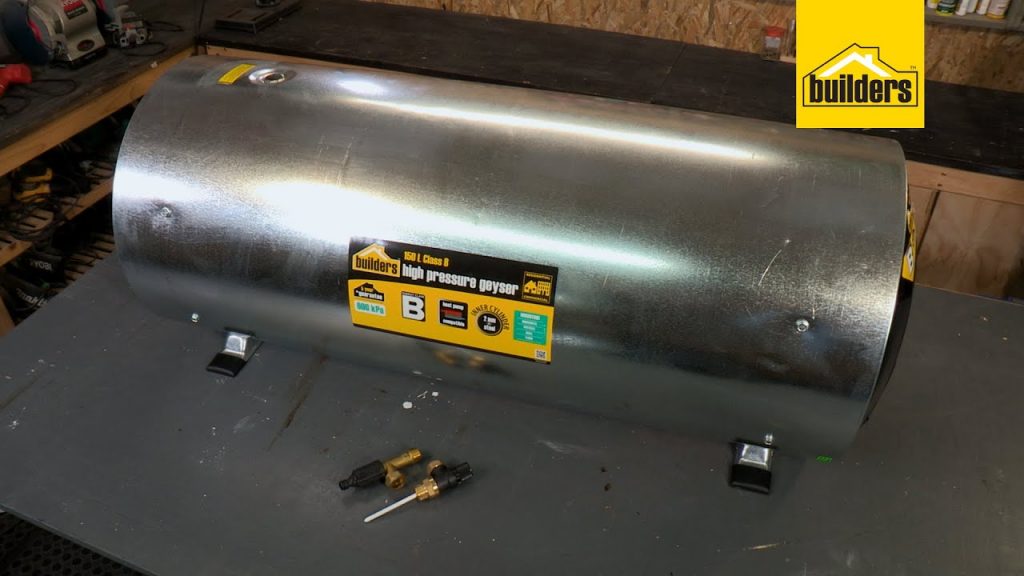
Think about how much energy is required to continuously maintain the temperature of that water.
Source: BuildersSA
Storage heaters collect cold water in a storage container. Electrical energy is then converted into heat energy and dispersed via a strategically placed element to heat the water — this is where the problem arises.
You see, a geyser requires an almost constant power supply to heat up and maintain the temperature of the water it stores.
The Result
That’s right, higher electricity consumption (more money spent).
Tankless Water Heater
In contrast, a tankless water heater can provide on-demand hot water, i.e., you don’t need to power it continuously for you to have hot water.
The Result
You guessed it, lower electricity consumption (increased savings).
Can Tankless Water Heaters Run Out Of Hot Water?
No, a tankless water heater cannot run out of hot water. These water heating systems heat water on demand, so as long as you have gas or electricity available, your tankless water system will continue to provide you with all the heat that you need.
However
While tankless water heaters can provide you with a continuous flow of hot water, they’re still at the mercy of gas and electricity availability.
As previously mentioned, all TWH require electricity to operate.
Electric heaters require electricity to heat the water, but both need electricity to power their remote thermostats, electric control system, and ignition system.
What we’re trying to get at here is this — it’d be in your best interest to invest in a renewable energy system (if it’s within your means). This way, you can be sure that your tankless water heater will provide you with hot water in an environmentally-friendly manner, no matter the situation.
Just think about it for a second — thanks to its battery storage options, a solar system (grid-tied or off-grid) can assist you, even during a power outage.
7 Best Tankless Water Heaters You Can Buy
1. Stiebel Eltron (239223)
Digital Display: provides you with accurate readings for temperature readings for maximum energy efficiency.
Pre-Set Temperature Buttons: this “Plus model” tankless water heater comes with temperature memory settings.
Monitoring: savings and water flow monitors provide you with a continuous flow of information.
Venting: No venting is required.
Tech Specs:
| Item Weight | 1 lb |
| Item Dimensions | 4.63 x 16.63 x 14.5 inches |
| Power Source | Electricity |
| Voltage | 240 Volts |
| Wattage | 28.8 kW |
2. EcoSmart (ECO 11)
Monitoring: continuously monitored water temperature and controlled flow rates ensure efficiency and consistent performance within 1 degree of the selected temperature
Save Space: EcoSmart tankless electric water heaters are 90% smaller than traditional tank heaters; they may be installed on a wall or at the point of use.
Sizing: 13-kilowatt tankless electric water heater ideal for providing hot water for multiple points of use or low-flow applications; it provides between 1.3 and 3.1 gallons per minute, depending on the inlet water temperature.
Tech Specs:
| Item Weight | 6.5 lbs |
| Item Dimensions | 3.75 x 8 x 11.5 inches |
| Power Source | Electricity |
| Voltage | 220 volts |
| Wattage | 13 kW |
| Flow Rate | Depending on the inlet water temperature, between 1.3 and 3.1 gallons per minute. |
3. Stiebel Eltron (230628)
Versatile: can deliver hot water to a single sink, multiple sinks, or in certain conditions, low-flow showerheads.
Temperature Control: set the temperature knob on the front cover, and enjoy water between 86–140 °F (30–60 °C). You can change your desired temperature whenever you like; advanced microprocessor technology ensures that your water temperature doesn’t deviate from the setpoint, even if the flow varies.
Constant Temperature Output: Stiebel’s Eltron Electronic Temperature Control compensates for fluctuations in the flow rate and the incoming water temperature to maintain a continuous water temperature output. Their intelligent microprocessor continually monitors info from the flow sensor & two temperature sensors and micro-adjusts the heating elements, saving you money.
Tech Specs:
| Item Weight | 5.94 lbs |
| Item Dimensions | 4.1 x 7.9 x 14.2 inches |
| Power Source | Electricity |
| Voltage | 240 volts |
| Wattage | 12 kW |
| Flow Rate | 1.5 gallons per minute |
4. Rinnai (V53DeN)
Optimal Water Pressure: up to 5.3 GPM hot water flow rate for a powerful, constant stream.
Protection: Enhanced scale detection lessens the possibility of severe and long-term damage to your unit.
Long Lifespan: 10-, 5-, and 1-year residential factory warranty for heat exchanger, labor, and parts.
Savings: rated by a Uniform Energy Factor (UEF), our tankless water heaters are highly energy-efficient, saving you from expensive power and water costs.
Tech Specs:
| Item Weight | 33 lbs |
| Item Dimensions | 10.5 x 27 x 18.5 inches |
| Power Source | Gas |
| Voltage | N/A |
| Wattage | N/A |
| Flow Rate | Up to 5.3 gallons per minute |
5. Rheem (RTEX-13)
Thermostat Control: unit comes with external adjustable digital thermostatic control with an LED display (+/1 degree accuracy)
Easily Serviced: Durable Copper immersion two heating elements that are field serviceable.
Hassle-Free Installation: 1/2 NPT adapters included; side 1/2 inch Compression water connections
Tech Specs:
| Item Weight | N/A |
| Item Dimensions | 12.63 x 8.25 x 3.63 inches |
| Power Source | Electricity |
| Voltage | 240 Volts |
| Wattage | 13 kW |
| Flow Rate | Up to 3.17 GPM |
6. Ecosmart (ECO)
Energy-Saving: Only heats water on demand, unlike a tank heater that maintains water temperature even when you’re not using it. You can save up to 50% on your energy savings.
Sizing: this tankless electric water heater can provide hot water for your entire home; it offers between 2.7 and 6.5 gallons per minute, depending on the inlet water temperature.
Warranty: Limited Lifetime Warranty on the electronics, exchanger, and element.
Tech Specs:
| Item Weight | 10.98 lbs |
| Item Dimensions | 3.63 x 17 x 17 inches |
| Power Source | Electricity |
| Voltage | 240 volts |
| Wattage | 27 kW |
| Flow Rate | Between 2.7 and 6.5 gallons per minute, depending on the inlet water temperature |
7. Camplux (Outdoor Portable Propane)
Portable: portable design makes it easy to use in any environment.
Hassle-Free Installation: you can install this tankless water heater within 5 minutes.
Extras: comes with 5 feet gas regulator, shower hose, and US standard garden hose.
CSA Safety Testing Standard: Flame failure device, anti-freezing protection, overheating protection to ensure your family’s safety. The anti-freezing drain plug discharges the residual water to avoid freezing in cold areas.
Warranty: 1-year limited warranty and 24/7 customer support in the USA.
Tech Specs:
| Item Weight | 14 lbs |
| Item Dimensions | 14.8 x 11.42 x 4.33 inches |
| Power Source | Gas |
| Voltage | N/A |
| Wattage | N/A |
| Flow Rate | Up to 1.32 gallons per minute |
Final Thoughts
It’s hard not to love these almost instant, space-saving, and cost-effective systems.
What’s more, the fact that you can choose between whole-house and point-of-use devices makes these systems incredibly versatile!
In short, we strongly feel that if you have the means, it’s well worth your time and money to invest in a tankless water heater!

